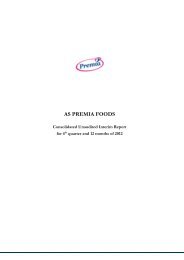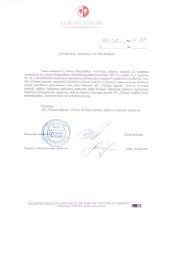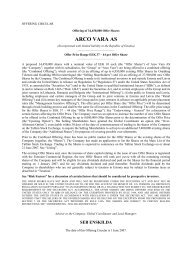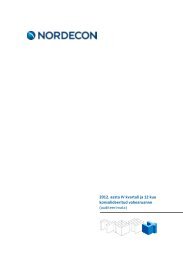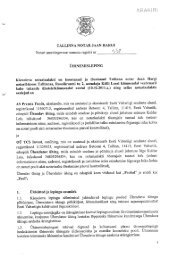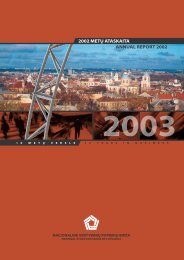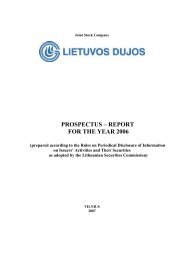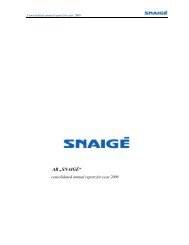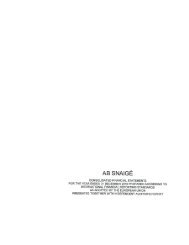Aktsiaselts Tallink Grupp - NASDAQ OMX Baltic
Aktsiaselts Tallink Grupp - NASDAQ OMX Baltic
Aktsiaselts Tallink Grupp - NASDAQ OMX Baltic
You also want an ePaper? Increase the reach of your titles
YUMPU automatically turns print PDFs into web optimized ePapers that Google loves.
The passenger and ro-ro cargo volumes on the key routes between Finland and Estonia, Finland and Sweden<br />
and Sweden and Estonia between 2002 and 2004 are shown in the below table:<br />
Passengers (million) 1 Ro-ro cargo units (thousands)<br />
Year ended December 31,<br />
2002 2003 2004 2002 2003 2004<br />
Finland—Estonia ...................................... 6.0 5.8 6.2 116 127 164<br />
Finland—Sweden ...................................... 8.7 9.1 9.4 233 243 264<br />
Sweden—Estonia ...................................... 0.4 0.5 0.7 42 52 51<br />
Source: ShipPax statistics<br />
1 A single passenger taking a round-trip is accounted for as two passengers for the purpose of this table.<br />
Cargo transport to and from Estonia has also grown rapidly with the growth of the Estonian economy and,<br />
more recently, with the European Union membership of the <strong>Baltic</strong> countries. Another factor aiding growth in<br />
cargo volumes is the development of the ‘Via <strong>Baltic</strong>a,’ a 670 km highway running from Tallinn to Poland. The<br />
Via <strong>Baltic</strong>a is the shortest route connecting Finland and parts of Russia with Continental Europe through the<br />
three <strong>Baltic</strong> countries of Estonia, Latvia and Lithuania. Traffic from more central parts of Europe to Finland (and<br />
also to St. Petersburg and other areas in Northwestern Russia) has traditionally been routed through Denmark and<br />
Sweden or by vessels directly from Germany. We expect that the recent accession to the European Union of<br />
Poland and the <strong>Baltic</strong> countries, the consequent removal of customs and the ongoing upgrading of local roads<br />
will increase the importance of cargo traffic routed through the Via <strong>Baltic</strong>a in the future. Please refer to the table<br />
above for statistics showing the recent development of ro-ro cargo traffic from Finland and Sweden to Estonia.<br />
Current and Future Tax Status of Onboard Sales<br />
As in several other European mini-cruise and passenger ferry markets, tax-free sales have played an important<br />
economic role in traffic in the Northern <strong>Baltic</strong> Sea region. Due to regulatory developments within the European<br />
Union, onboard tax-free shop sales (excluding bar and restaurant sales and onboard consumption) on routes between<br />
the European Union member states have ceased. The Finnish province of Åland, however, is exempt from the<br />
relevant European Union regulations. As a result, it has been possible for ferry operators to route ferries between<br />
Sweden and Estonia and between Finland and Sweden through Åland and tax-free shop sales on these particular<br />
routes have accordingly been preserved. The stopover in Åland does not increase journey time significantly. Traffic<br />
on the Kapellskär—Paldiski route is not routed through Åland, and, as a result, tax-free shop sales are not available<br />
on this route. Compared to the Stockholm—Tallinn route, the demand for tax-free sales in shops on the<br />
Kapellskär—Paldiski route is lower and the value that customers place on faster transport between Sweden and<br />
Estonia is greater. As of the date of this offering memorandum, there is no time limitation on Åland’s special status<br />
and we believe that Åland will continue to enjoy such status for the foreseeable future.<br />
Alcohol and tobacco sales have traditionally been subject to a relatively high degree of regulation in Finland<br />
and Sweden. High taxation rates have elevated the price of alcoholic beverages and tobacco in Finland and<br />
Sweden compared to most other countries in the European Union (Swedish and Finnish excise taxes have been<br />
up to ten times higher than the European Union minimum excise tax level of EUR 5.50 per liter of pure alcohol).<br />
Estonia’s lower excise tax rates (Estonia currently has a moderate excise tax level of EUR 9.06 per liter of pure<br />
alcohol) and onboard prices, together with the relaxation of Finnish and Swedish private import quotas for<br />
alcoholic beverages and tobacco, have led to increased sales in onboard shops as well as for shops in Tallinn.<br />
Minor amendments in excise tax rates on alcohol are being considered by the Estonian Parliament in order to<br />
apply the same excise tax rates in respect of wine and fermented beverages (other than beer). It is not yet clear<br />
whether the excise tax on fermented beverages will be increased or the excise tax on wine will be decreased. As<br />
excise taxes on alcohol in Finland and Sweden constitute an important source of tax revenue for both countries,<br />
the Finnish and Swedish governments have, in order to maintain the competitiveness of local prices, engaged in<br />
discussions seeking to reduce unit-specific excise taxes on alcohol in the future. Finland has already implemented<br />
a moderate decrease of these excise taxes as of March 1, 2004.<br />
Competition<br />
In addition to us, the largest companies by revenue that provide mini-cruise and passenger transport services<br />
in the Northern <strong>Baltic</strong> Sea region are Viking Line, Silja Line, Eckerö Linjen and Birka Line. There are also a<br />
number of smaller ferry companies, such as Nordic Jet Line and Linda Line operating only with high-speed<br />
ferries between Helsinki and Tallinn. For both Viking Line and Silja Line, the majority of revenue originates<br />
from routes between Finland and Sweden on which we do not operate. Eckerö Linjen only operates regular<br />
passenger and cargo traffic between Finland and Estonia and Sweden and Finland, whereas Birka Line primarily<br />
concentrates on traffic to or via Åland. For further discussion concerning the competitive environment, see<br />
“Business—Competition.”<br />
47



